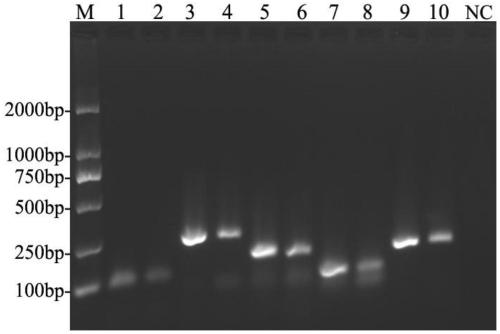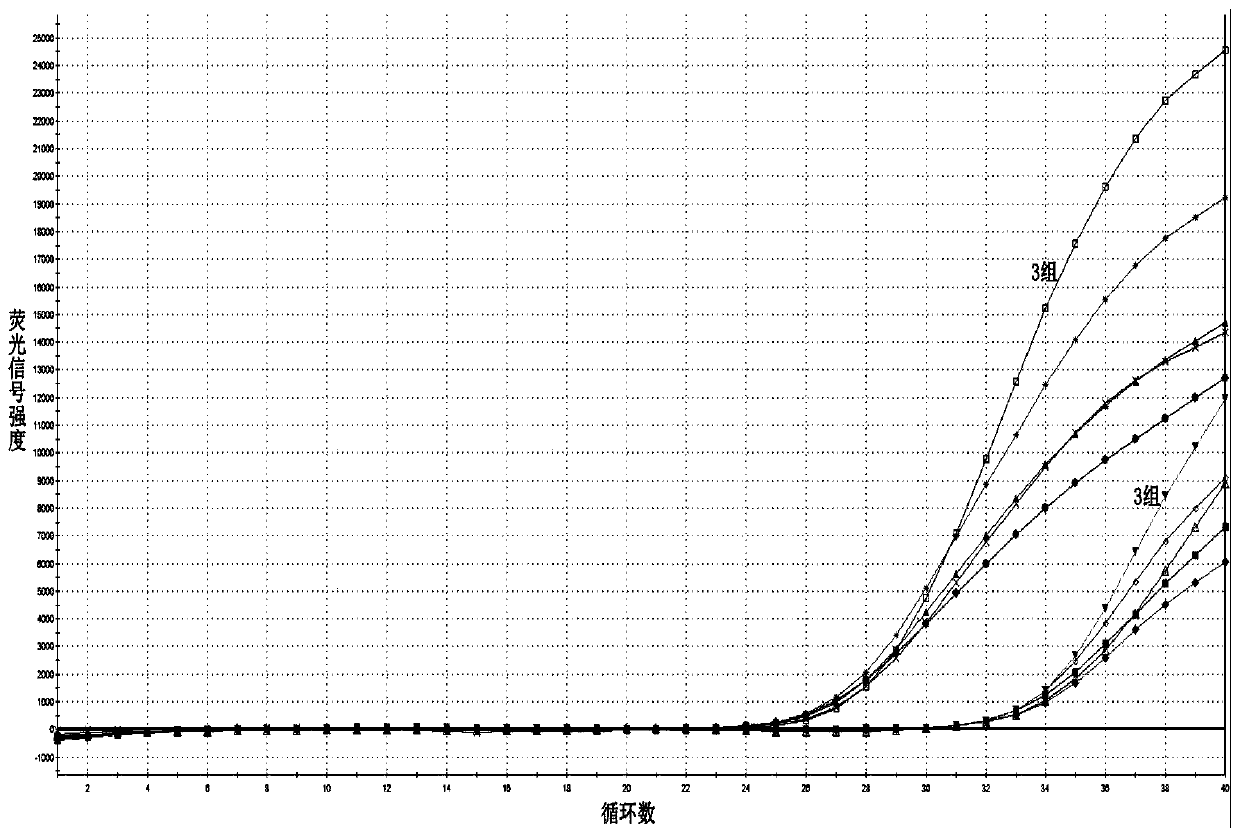Primer set for performing fluorescence quantitative PCR detection on decapod iridescent virus 1 ( Decapod iridescent virus 1, DIV1 ) and reagent kit
A detection kit and fluorescence quantitative technology, which are applied in the determination/inspection of microorganisms, recombinant DNA technology, biochemical equipment and methods, etc., can solve the problems of false positive, cumbersome operation, easy cross-contamination, etc. High sensitivity and good repeatability
- Summary
- Abstract
- Description
- Claims
- Application Information
AI Technical Summary
Problems solved by technology
Method used
Image
Examples
Embodiment 1
[0042] Design and synthesis of primers and TaqMan-MGB probe for detecting Decapod iridescent virus 1 (DIV1).
[0043] The major capsid protein (MCP) gene of iridovirus contains many highly conserved domains, so the MCP gene of DIV1 was used as the detection target gene. Using Primer Express 3.0 software, according to the design principles of fluorescent quantitative PCR primers and MGB probes, multiple sets of specific amplification primers and TaqMan-MGB probes were designed and screened in the conserved region of the MCP gene (KY681039), and analyzed and compared by Oligo7.0 software. Appropriately modify and optimize to obtain 5 groups of ideal primers and probes (see Table 1). After Blast homology comparison and verification through the NCBI database, they will be synthesized by Shenggong Bioengineering (Shanghai) Co., Ltd., wherein the 5' end of the probe Label the fluorescent dye FAM, and label the MGB group at the 3' end.
[0044] Table 1 Primer and probe information f...
Embodiment 2
[0051] Extraction of pathogenic nucleic acid and preparation of recombinant plasmid standards.
[0052] Take 50mg of positive diseased tissue, and follow the instructions of the animal tissue genomic DNA rapid extraction kit to extract common shrimp pathogens DIV1, WSSV, IHHNV, EHP and Vp AHPND Finally, add 50 μL of elution buffer (EB) to dissolve the DNA, and store at –20°C for later use.
[0053] Using the DNA extracted from the DIV1-positive material as a template, PCR amplification was performed using primers DIV1-qF1 and DIV1-qR1 (amplification conditions are the same as in Example 1), and the product was recovered and purified by agarose gel and ligated with pMD18-T to transform DH5α , to prepare the recombinant plasmid pMD18-T-MCP DIV1 , and identified by PCR and sequencing. Extract the recombinant plasmid pMD18-T-MCP DIV1 , use a nucleic acid and protein analyzer to measure its concentration and convert it to copy number, and dilute to 1.0×10 in a 10-fold gradient ...
Embodiment 3
[0056] Optimization of reaction conditions for fluorescent quantitative PCR.
[0057] With 3 gradients (1.0×10 5 , 1.0×10 3 , 1.0×10 1 copies / μL) of the standard DNA as a template, in the range of 56 ~ 64 ° C with a gradient of 1 ° C as the annealing temperature for fluorescent quantitative PCR amplification (other conditions are the same as in Example 1), to obtain a lower threshold cycle number (Ct value) and higher relative fluorescence intensity increase value (ΔRn) is the best annealing temperature.
[0058] The results show that when the annealing temperature is 58°C, the Ct value is the smallest and the ΔRn is the highest, indicating that both the primer and the probe can be well combined with the template when the annealing temperature is 58°C, so 58°C is selected as the optimal annealing temperature in the present invention. Among them, the initial template concentration was 1.0 × 10 3 Refer to Table 3 for the amplification effect data of the fluorescent quantitat...
PUM
 Login to View More
Login to View More Abstract
Description
Claims
Application Information
 Login to View More
Login to View More - Generate Ideas
- Intellectual Property
- Life Sciences
- Materials
- Tech Scout
- Unparalleled Data Quality
- Higher Quality Content
- 60% Fewer Hallucinations
Browse by: Latest US Patents, China's latest patents, Technical Efficacy Thesaurus, Application Domain, Technology Topic, Popular Technical Reports.
© 2025 PatSnap. All rights reserved.Legal|Privacy policy|Modern Slavery Act Transparency Statement|Sitemap|About US| Contact US: help@patsnap.com



